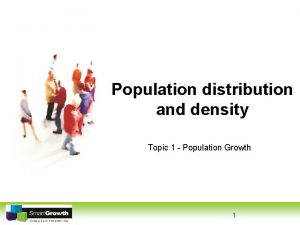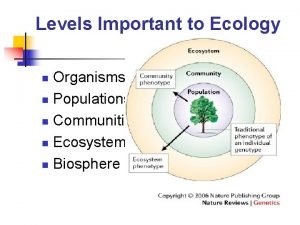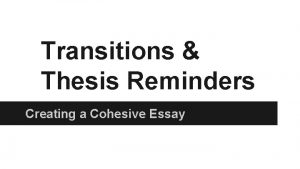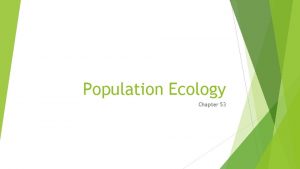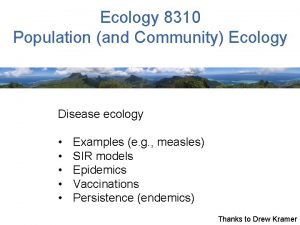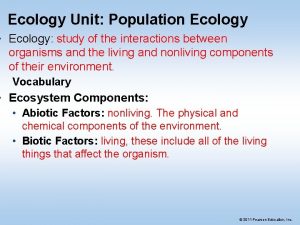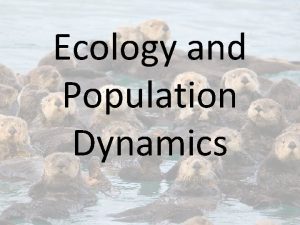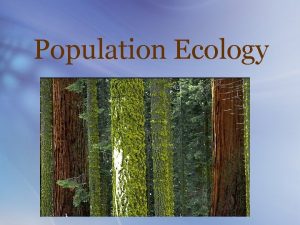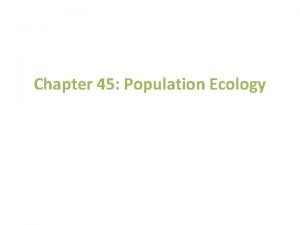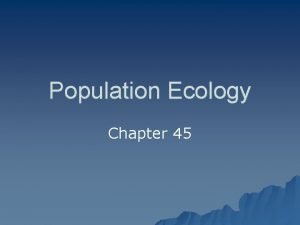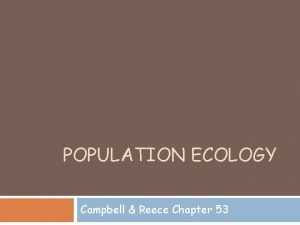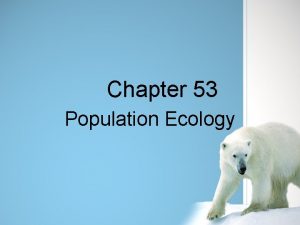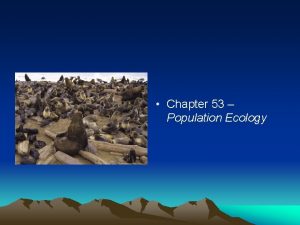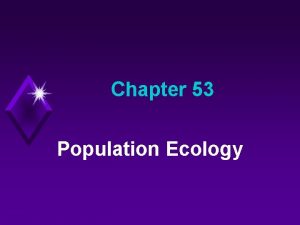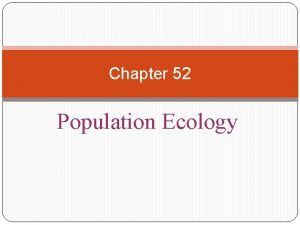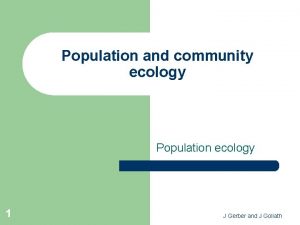Population Ecology CHAPTER 53 Reminder A population is























- Slides: 23

Population Ecology CHAPTER 53

Reminder: A population is a group of individuals of a single species living in the same general area

I. Populations A. Population Ecology – how biotic and abiotic factors influence density, distribution, size, and age structure of populations B. Density – number of individuals per unit of area or volume 1. Increases by births & immigration, decreases by deaths and emigration

C. Population Sampling 1. Sampling techniques can be used to estimate densities and total population sizes 2. Population size can be estimated by either extrapolation from small samples, an index of population size, or the markrecapture method N=mn/x = (# in 1 st sample)(# in 2 nd sample)/# marked in 2 nd sample

D. Dispersion – pattern of spacing among individuals 1. Clumped, uniform, or random

E. Demography – study of vital statistics of a population, especially birth and death rates, represented by survivorship curves

1. Survivorship curves a. Type I – low death rates during early and mid life, increase sharply among older groups (large organisms with long life spans b. Type II – constant death rate over life span, often prey c. Type III – high death rates early, flat in older groups

II. Population Growth A. Useful to study in ideal situation of no migration Change in Population size over time d. N – size of population at a particular instant in time dt - time interval of the calculation B = births D = deaths

Fig. 53 -3 Births and immigration add individuals to a population. Immigration Deaths and emigration remove individuals from a population. Emigration

Sample Problem In 2006 the United States had a population of about 300 million people. If there were 14 births and 8 deaths per 1000 people, what was the country’s net population growth that year? (ignore immigration and emigration) d. N b. N-d. N dt

Sample Problem In 2006 the United States had a population of about 300 million people. If there were 14 births and 8 deaths per 1000 people, what was the country’s net population growth that year? (ignore immigration and emigration) Net gain of 6 per every 1000 d. N b. N-d. N dt (300, 000/1000) x 6 1, 800, 000 (14 -8)

B. Exponential growth- occurs under ideal conditions (no constraints) rmax – maximum per capita rate of increase N – population size

C. Logistic growth – when density-dependent and densityindependent factors are imposed, increases exponentially at first but then levels off as it approaches carrying capacity K = carrying capacity

1. Carrying capacity – max population size that the environment can support at a given time without degrading the habitat 2. If there is no migration, population growth rate = birth rate – death rate

Sample problem: If a population is 1600, and the r. MAX is 1. 0, what is the growth of a population with a carrying capacity of 1500? (K N) d. N rmax N dt K

Sample problem: If a population is 1600, and the r. MAX is 1. 0, what is the growth of a population with a carrying capacity of 1500? (K N) d. N rmax N dt K (1. 0) (1600) [(1500 -1600)/1500] = -106. 67

III. Life History – traits that affect an organism’s schedule of reproduction and survival rate A. 3 factors 1. How early? (at what age does reproduction begin? ) 2. How often? (repeated reproduction or big-bang? ) 3. How many? (litter size)

B. K-selection – selection for life history traits that are sensitive to population density and carrying capacity 1. Operates in populations living near carrying capacity C. r-selection – for populations not near, carrying capacity, favors maximizing reproductive success Little competition, undemanding young, often in exponential growth More competition, more demanding young, more often in logistic growth

IV. Regulation of population growth (limiting factors) A. Density-dependent factors – factors that limit population size that are dependent on population density 1. Cause death rate to rise and birth rate to fall as population density increases 2. Includes competition for resources & territory, disease, and predation

B. Density-independent factors – population density is irrelevant, usually things like natural disasters, drought

V. Human population growth A. Exponential until the 1960 s (2. 2% at its peak, about 1. 1% in 2011) B. Demographic transition – change in birth/death rates

C. Age-structure pyramids – show relative numbers of individuals in each age group in a population 1. Used to predict and explain demographic patterns

D. Global carrying capacity 1. Currently unknown 2. Ecological footprints – total resources a person consumes In hectares – currently thought that 1. 7 hectares/person is sustainable
 Chapter 4 section 1 population dynamics study guide
Chapter 4 section 1 population dynamics study guide Chapter 4 section 1 population dynamics
Chapter 4 section 1 population dynamics Population ecology section 1 population dynamics answer key
Population ecology section 1 population dynamics answer key Population ecology section 1 population dynamics
Population ecology section 1 population dynamics Chapter 53 population ecology
Chapter 53 population ecology Chapter 36 population ecology
Chapter 36 population ecology Ecology
Ecology Chapter 53 population ecology
Chapter 53 population ecology Chapter 4 population ecology answer key
Chapter 4 population ecology answer key Chapter 53 population ecology
Chapter 53 population ecology Population ecology example
Population ecology example Define exponential population growth
Define exponential population growth 52
52 Population vs community ecology
Population vs community ecology Concept 3 population ecology
Concept 3 population ecology Lynx and hare relationship
Lynx and hare relationship What is uniform dispersion
What is uniform dispersion Population characteristics
Population characteristics What is population ecology
What is population ecology Population definition ecology
Population definition ecology Population ecology
Population ecology Parasitism
Parasitism Cohesive thesis statement
Cohesive thesis statement Stir you up by way of reminder
Stir you up by way of reminder




















